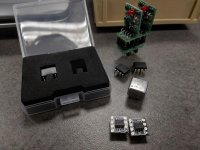There were LH right? Hybrid. M is monolithic right? And then LMH monolithic high speed.I especially enjoyed the change National made from LM (everything) to LME (audio), LMP (precision), LMX (frequency synthesizers), LMK (clocking - which somehow is different from frequency synthesizers), LMV (general purpose opamps), etc. I think it was a good move, even if the transition was a bit rough.
Tom
There were LH right? Hybrid. M is monolithic right? And then LMH monolithic high speed.
LM = Linear Monolithic
LH = Linear Hybrid
DM = Digital Monolithic
which explains why National's part number for a TTL quad NORgate IC was DM7402.
There were LH right? Hybrid. M is monolithic right? And then LMH monolithic high speed.
I'm pretty sure LMH came as part of the LM -> 3-letters transition. LMH is high-speed.
Tom
Don't forget LMH (High speed)! Since my move to lead the high speed amplifier business I've learned to appreciate that prefix. Fun fact, I learned from a forum member here that the LMH6629 will still work down at 40 Kelvin!
Fun fact, I learned from a forum member here that the LMH6629 will still work down at 40 Kelvin!
40 K. Dang... That's a bit nippy. 🙂 Last I dealt with temperatures in that range was when I dealt with ultra-high vacuum systems and associated cryopumps.
Tom
Applied through mouser to get a few samples. I couldn't get direct.
I wonder, have anybody actually listened to this nice opa1656, and are able to provide some feedback on its sound ?
I dropped one on the workbench and it made sort of a tick-tick sound as it landed. 🙂 
On a more serious note: I've measured the OPA1656 as part of a headphone amp I'm building. I see no indications that it would contribute anything audible to the sound.
Tom

On a more serious note: I've measured the OPA1656 as part of a headphone amp I'm building. I see no indications that it would contribute anything audible to the sound.
Tom
Last week TI put a preliminary datasheet online for the OPA1656, a low noise, very low distortion op amp targeting audio applications and fabricated in a CMOS process.
Will there also a single chip as OPA1655 available?
And how those compete against the LME49720 😀
Hp
Will there also a single chip as OPA1655 available?
And how those compete against the LME49720 😀
Hp
Last week TI put a preliminary datasheet online for the OPA1656, a low noise, very low distortion op amp targeting audio applications and fabricated in a CMOS process.
http://www.ti.com/product/OPA1656
I just checked and the sample button for the prototype devices is now active:
http://www.ti.com/product/OPA1656/samplebuy
I started this project in 2017 with the designer of the OPA1622, and although I had a change in my role at TI before the device was released to market, I'm still very proud of what was accomplished. The goals of the project were fairly straightforward:
1. Start with the OPA1688 architecture which gives very good distortion performance, even with low-impedance loads. Beef up the output
A quick snapshot of the OPA1656 performance specs:
- 2.9nV/rtHz broadband voltage noise
- 6 fa/rtHz broadband current noise
- -131 dB THD+N at 1kHz, 600 ohm load, 3.5Vrms signal, 80-kHz measurement bandwidth
- 53 MHz gain bandwidth product, 24V/us slew rate
- >100mA output current
- 4.0mA typical supply current, 4.5mA max
I'm looking forward to seeing what people think of the device, and hopefully it finds its way into a few projects on here!
Any comment on single opamp ???
How about making quad variant of OPA1656?
It would be totally great news for me 🙂
OPA1604 is best part available now, I think it's time to introduce something newer.
It would be totally great news for me 🙂
OPA1604 is best part available now, I think it's time to introduce something newer.
±20 V, 100 mA, THD ~-130 dB @ 2 kΩ load. $1-something @ QTY 1k. What's not to like? 🙂
It looks like this one has the phase kink (lead/lag compensation) towards UGBW as well. That's the only drawback I can see. It makes it a little harder to use this opamp in a composite amp. That's not a show stopper, though. I'll just have to work harder to get around it.
Nice work John (et al.)
Tom
Sorry, I am new to these. I wanted to know why phase kink towards UGBW is a drawback ?
Is the OPA 1656 capable of driving headphones?
Yes.
Headphones were a key application I considered in the development of the OPA1656. This was one of the reasons we started with the architecture of the OPA1688, and then beefed-up the output transistors to deliver even higher power than the OPA1688.
That's good to know; I suspected as much when I saw the 100 mA drive current capability. But I was concerned because the datasheet doesn't show any graphs for distortion with loads < 600Ω, and shows an application note depicting the use of an additional BUF 634 for driving headphones---perhaps this is only necessary for 8/16Ω loads? Also, I noticed that the distortion rises somewhat @ 10-20K Hz when driving the 600Ω load as compared to the 2KΩ load. Is it then good to go for 32Ω phones? If so, it's a pretty amazing feat for a 8-pin SOIC chip, indeed!
- Home
- Vendor's Bazaar
- OPA1656: High-Performance CMOS Audio Op Amp
